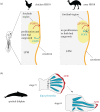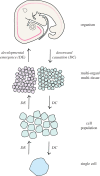Tissue tectonics and the multi-scale regulation of developmental timing
- PMID: 34055304
- PMCID: PMC8086930
- DOI: 10.1098/rsfs.2020.0057
Tissue tectonics and the multi-scale regulation of developmental timing
Abstract
Development encompasses processes that occur at multiple length scales, including gene-regulatory interactions, cell movements and reorganization, cell signalling and growth. It is essential that the timing of events in all of these different processes is coordinated to generate well-patterned tissues and organs. However, how the timing of intrinsic cell state changes is coordinated with events occurring at the multi-tissue and whole-organism level is unknown. Here, we argue that an important mechanism that accounts for the integration of timing across levels of organization is provided by tissue tectonics, i.e. how morphogenetic events driving tissue shape changes result in the relative displacement of signalling and responding tissues and coordinate developmental timing across scales. In doing so, tissue tectonics provides a mechanism by which the cell specification events intrinsic to cells can be modulated by the temporal exposure to extracellular signals. This exposure is in turn regulated by higher-order properties of the embryo, such as their physical properties, rates of growth and the combination of dynamic cell behaviours, impacting tissue morphogenesis. Tissue tectonics creates a downward flow of information from higher to lower levels of biological organization, providing an instance of downward causation in development.
Keywords: developmental; multi-scale; review; tectonics; timings; tissue.
© 2021 The Authors.
Figures





References
-
- Slack J. 1983. From egg to embryo. Cambridge, UK: Cambridge University Press.
Publication types
LinkOut - more resources
Full Text Sources
Other Literature Sources
